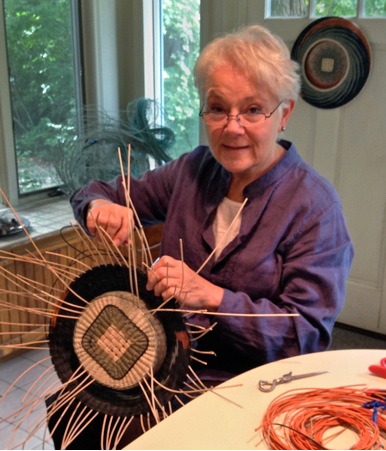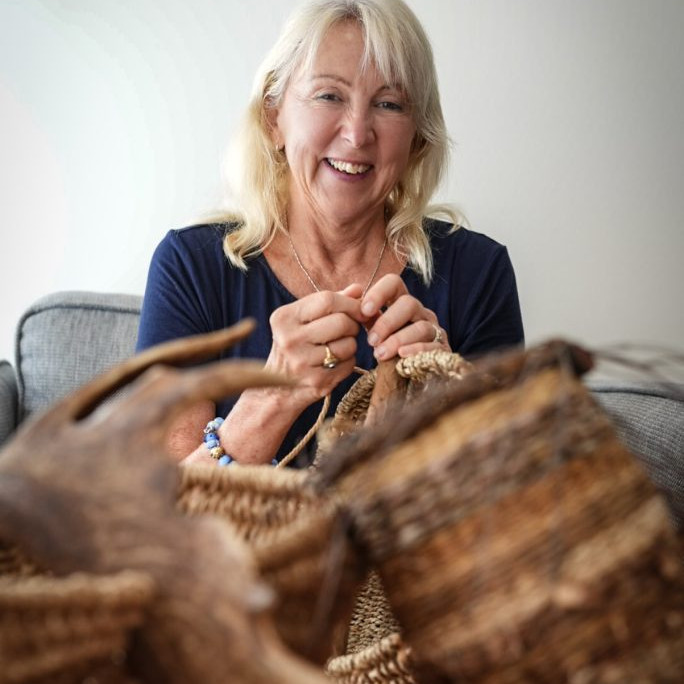Kari Lønning BasketMaker - Connecticut, USA
I keep coming across ‘encaustic’, which is taking on a ‘new’ life. Can you explain how it is part of your work? How does this affect the colour process? How have you adapted encaustic into your basket weaving?
Encaustic painting was used as far back as 100-300 AD in Egypt. The wax was heated up, pigments were added and the mixture was applied to a surface. I use clear beeswax and demar resin mixture on my finished baskets.
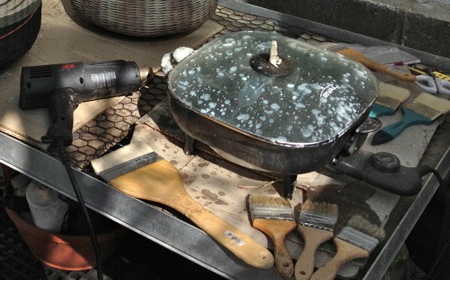
Encaustic pan, brushes, gun
Where you do this and why?
I work on the encaustic in my greenhouse where a ventilation system was set up to remove excess heat from the plants. The fans work to draw off the wax/resin fumes as the medium is heated up. The process involves brushing the liquefied wax onto the outer and inner surfaces of the baskets. A heat gun is then used to melt the gloppy mess into the fibre of the rattan. The wax seals out air borne pollutants (which in turn keeps the natural reed white), protects the baskets from potential mildew, makes the colours appear richer and adds strength to the walls./p>
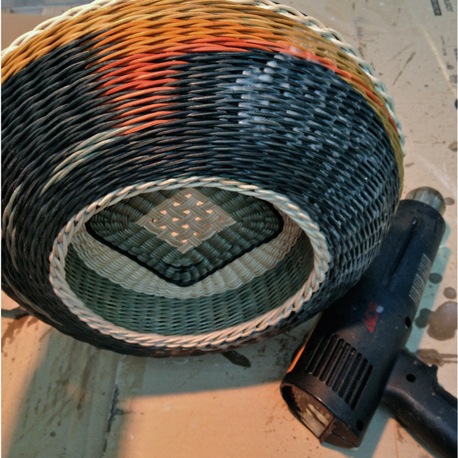
Encaustic on 2 sided Gem
What materials do you use in your baskets and where do you source them?
I use round, rattan reed which I buy directly from a wholesaler. He gets it from China, where it is milled to size and bleached.
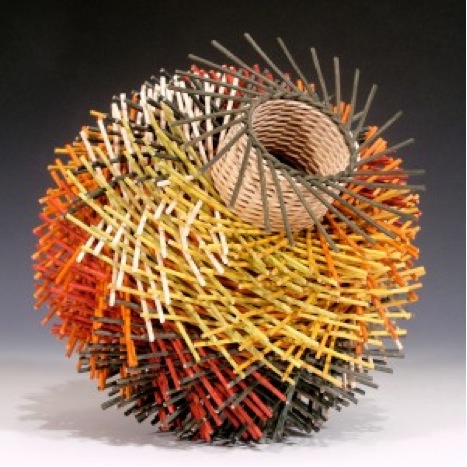
You do commission work; can you expand on this process in relationship to the client who sent you a grey and orange tile?
The client who commissioned a basket to go with her ceramic tile, found me at a craft show last fall. We discussed which baskets she liked and why they appealed to her (patterns, colour usage, texture). She sent me the tile and the dimensions for the location where she wanted to place the basket. I began dying reed. When I got colours I thought she’d like, I sent her samples of the four dye lots I did, with a design sketch. (I use procion textile dyes which are water safe and as light resistant as the best upholstery fabrics.)
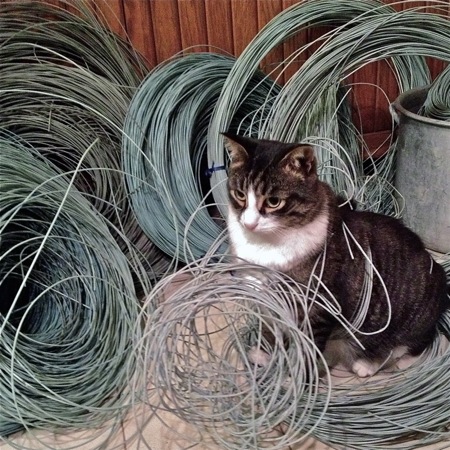
Kitt, the Cat and reed
She liked the colours so much she asked if I’d make her two baskets. She wanted them to be different designs, but to have them work as a set. I started with one basket, and sent her photographs. We narrowed down her preferences; she preferred less orange used as an accent, you can see in the detail below. I followed up with two more baskets.

Note: The 2 orange and 3 grey-green weavers above. I refer to weaving with 5 weavers.

‘Zafron Baskets’
Can you take us through the process of your work?
The wall pieces I make begin with a grid where the back half of the reed is carved away. This allows for a tighter beginning and a flatter surface. Rows of tapestry are woven back and forth in order to build up the flat sides of the square, transitioning the square into a circle. To begin the spiral pattern, I add 3 more blue weavers and 1 natural one. After a few rows, I replace one of the blue weavers with a second natural and weave a few rows. I continue replacing blue with natural until all five weavers are natural. This creates the pinwheel effect. The orange accents are added using a tapestry technique. A weaver is cut and replaced with a short piece of orange for one weave-step.

‘Sage’
The orange is then cut and replaced with the original colour. This process happens every time the orange appears. Ends are tucked into the weave, hiding where each reed starts and stops.
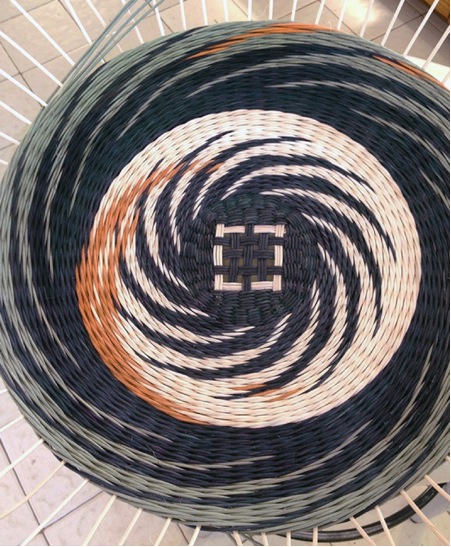

‘Sage’
“My whole output comes from one divisible creative force…” can you expand on this statement?
I believe the idea you are referring to has to do with a comment I made saying that my whole life is about creating; be that creating a basket or a garden, or a photograph. I see colour and design, and inspiration all around me. For me, creativity and inspiration are everywhere and touch every aspect of my life.
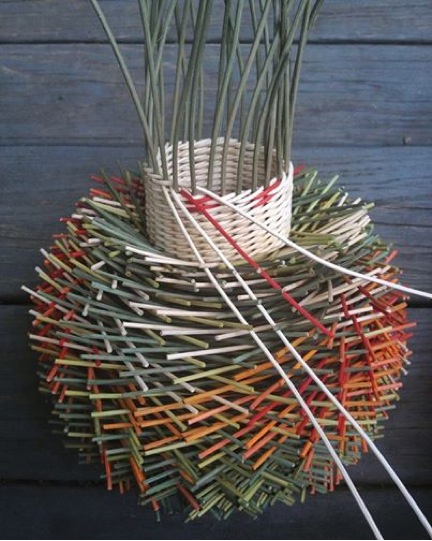
Your former training – how has this influenced your artistic journey? Can you explain the different shapes your work takes?
In college I studied ceramics and textiles. Throwing clay on the wheel taught me about form and gave me a feel for the spirals in the flat wall pieces. Weaving on the loom taught me about the structure of fabric, and about designing patterns. Together, they prepared me to weave the vessel forms and the spinning wall pieces I create.

‘Wavy Top’
You have a term ‘Hairy’ can you expand on this?
Technically – Your inspiration
The “hairy” technique is a method of alternating rows of weaving, with rows of short pieces inserted one at a time, behind each spoke, to create texture. The idea came from my wanting to weave a nest for my cousin’s aviary. The basket needed texture in order to sit in the branches and muted colours to blend into the leaves. My cousin wouldn’t put the nest outside, so I made a second one, saying that one was for the birds. After making two ‘nests,’ I understood what the birds had known all along, how to weave a textured surface using materials; they had at hand. For me, that was dyed reed. I had discovered a new way to work with colour.

Discuss the importance of photography in your work?
Inspiration/Colour
Photography is a passion. I use it to capture moments and details around me, as well as a way to network with artists and friends around the world. In the garden and woods, I take pictures of colours and nature’s designs. These photos are often used for basket inspiration and for creative editing. I use a photo sharing app called Instagram, where I learn, share and get feedback from other photographers. The photo below shows how the colours used in a Norwegian friend’s photo, were the inspiration for a basket.

‘Mortenbk Hydrangea’
inset photo used with permission from @mortenbk on Instagram
Importance of good photography for your completed work
Good documentation of artwork cannot be stressed enough. The physical work can only be seen by a limited number of people and once the piece is sold, all one has left is the photograph. Galleries and the press are always looking for good photographs. Collectors and museums look to photographs for reference. The better the photography, the greater the opportunities. As an example, the image below is a collage of photographs from different times. The carrot photo was the inspiration for the basket featured with it. I used an app on the iPhone to make the grouping in order to show the different sides of the basket. This photo was chosen by the National Basketry Organization to feature on the cover of their current magazine. The photo on the left was part of the first page of their article. By documenting my work as I went along, I was prepared for the feature article and, could print this small poster to have at craft shows.
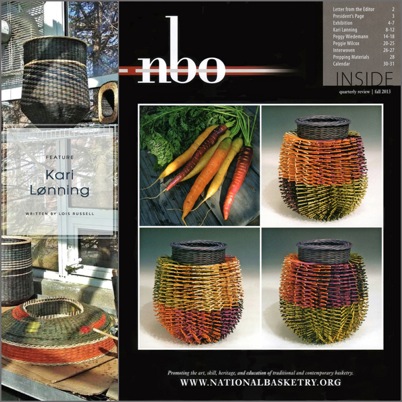
Gardening is also a passion, can you discuss this?
Being in and around plants and nature has always been important to me. As a child, I was more of a collector. I would dig up wildflowers and plant them in a little garden near the house. As an adult, I still collect, but after 30 years of being in the same house, most of my land is covered by perennials or bushes. As the plants have matured and multiplied, I’ve become more of an active observer and caretaker. As an alternative to the control I have over my baskets, I am content to stand back and let Mother Nature design as she sees fit, with minimal interference on my part.
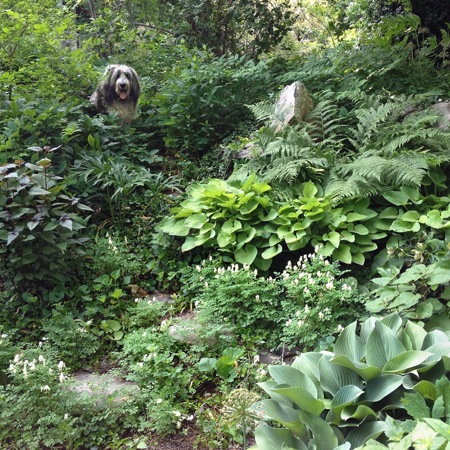
You work with dyes and hard vegetation materials. How do you care for your hands?
Not a very interesting answer; when I use procion dyes (fibre reactive textile dyes) I use light weight rubber gloves. While I’m weaving, I pay attention to what’s about to wear out and use my hands differently. Since I use my hands differently while weaving “hairy” baskets and the ones with flat surfaces, I often alternate between the two styles, finishing one then beginning a new one. This keeps the different parts of my hands from wearing out.
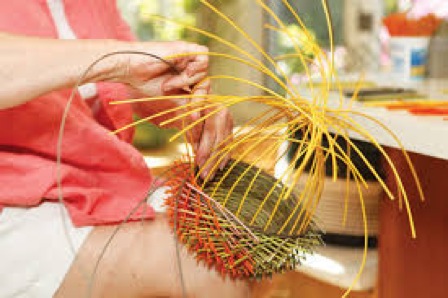
Photo by Amy Dolego
You also give workshops. Can you explain the direction these take?
I don’t teach often, but when I do, the high point comes in watching people who often have never seen themselves as “artists,” glow with pride as they are able to make a basket. My joy has more to do with students discovering their own abilities, than in having them complete a project. I teach technique and not “projects.” I give students the information to design and weave their own baskets, and the results are as different as they are.

Contact Details
Website: http://karilonning.com
Blog: karilonning.blogspot.com
Facebook: facebook.com/karibaskets
Kari Lønning, Connecticut, USA
Interview by Deborah Blakeley, January, 2014
Think a colleague or friend could benefit from this interview?
Knowledge is one of the biggest assets in any business. So why not forward this on to your friends and colleagues so they too can start taking advantage of the insightful information the artist has given?
Other artists you may be interested in:


